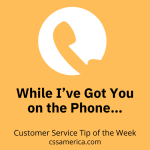
One of the characteristics of customer service where I “hang my hat” is Responsiveness. It’s an aspect of customer communications that conveys you care, that the other person is important to you, and that their need or issue warrants your quick attention.
But what is “Responsiveness?” It may mean different things to different people. And to illustrate that point, noted below are some definitions and examples of Responsiveness that were shared by employees at 3 recent client workshops:
- Follow-up quickly, Keep them in the loop, Tell them “I’m going to help you”, Give timeframes (set expectations), Provide them with what they need, Communication – be consistent.
- Set expectations for the customer, Set up timeframes, Set expectations for next steps, Keep the customer informed, Be prompt.
- Tell what you’re going to do and do it, Respond timely, Keep the customer informed – especially if there’s an issue – even if it’s not resolved, Follow-up.
Note that in many of these definitions and examples there’s an aspect of speed. There’s a focus on having ongoing communications with customers (even if it’s just for status updates). There’s a focus on helping the other person – and telling them that you want to help them. And there’s a component where you’re setting/managing expectations for responsiveness.
If you, your organization, or your customers put a premium on responsiveness, ensure that you have a clear picture of what that means and how it looks in your interactions with others. Make sure you have the needed speed, frequency of customer communications, clarity on your desire to help them, and expectation management.
Then your customers may just define Responsiveness…as YOU!
Signup for FREE Tips! Contact Us More Resources for You Visit Our Home Page























